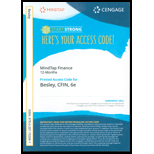
The bond has a face value of $1,000 with a coupon rate of 9% paid semi-annually. Also, the bond will mature in next 8 years with a required return of 4%.
Bonds are issued to raise funds for the company. The important characteristic of a bond is that it has a maturity value which is the value the bondholders will get at the end of the maturity period. Also, some bonds carry coupon rate which means the bondholders will get a regular interest cash flow on that bond.
The yield to maturity (YTM) of the bond is the required
Where,
INT = coupon payments made
N = number of periods
M = Maturity or Face value
rd = rate of return
Vd = Value of the bond
Want to see the full answer?
Check out a sample textbook solution
Chapter 6 Solutions
CFIN -STUDENT EDITION-ACCESS >CUSTOM<
- please don't use ai and if you cant understand given values please don't answer question otherwise unhelpful will be given.arrow_forwardfinance subjectarrow_forwardCould you help explain, what is the complete salary survey analysis, and ensuring the data is relevant and up-to-date? What is the job evaluation and compensation plan? How to ensure the final report is comprehensive, clearly structured, and aligned with the company vision?arrow_forward
- The maturity value of an $35,000 non-interest-bearing, simple discount 4%, 120-day note is:arrow_forwardCarl Sonntag wanted to compare what proceeds he would receive with a simple interest note versus a simple discount note. Both had the same terms: $18,905 at 10% for 4 years. Use ordinary interest as needed. Calculate the simple interest note proceeds. Calculate the simple discount note proceeds.arrow_forwardWhat you're solving for Solving for maturity value, discount period, bank discount, and proceeds of a note. What's given in the problem Face value: $55300 Rate of interest: 10% Length of note: 95 days Date of note: August 23rd Date note discounted: September 18th Bank discount rate:9 percentarrow_forward
 EBK CONTEMPORARY FINANCIAL MANAGEMENTFinanceISBN:9781337514835Author:MOYERPublisher:CENGAGE LEARNING - CONSIGNMENT
EBK CONTEMPORARY FINANCIAL MANAGEMENTFinanceISBN:9781337514835Author:MOYERPublisher:CENGAGE LEARNING - CONSIGNMENT
